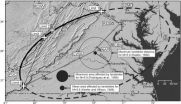(Press-News.org) SAN DIEGO – (Monday, November 5, 2012) – Heart disease risk factors are widespread among Hispanic/Latino adults in the United States, with 80 percent of men and 71 percent of women having at least one risk factor for heart disease, according to a San Diego State University study funded by the National Institutes of Health. These percentages are much higher than the general population, where approximately 49 percent of adults have at least one major risk factor for heart disease and stroke.
Findings from the Hispanic Community Health Study/Study of Latinos (HCHS/SOL), which will be published in the, Nov. 7, Journal of the American Medical Association (JAMA), shows that the prevalence of risk factors varies across Hispanic/Latino background groups, with some groups, particularly those with Puerto Rican background, experiencing high rates of heart disease risk factors compared to other groups.
Participants who are more "acculturated" (born in the United States or lived in the United States for 10 years or longer and preferred English vs. Spanish) were significantly more likely to have three or more risk factors. Those individuals self-reported higher rates of heart disease and stroke. Individuals with lower education or incomes were also significantly more likely to have multiple risk factors.
Findings from this phase of the study include self-reported information on heart disease and stroke and clinically measured risk factors. The study team will continue to follow participants to learn how risk factors change over time and how they influence the risk of developing cardiovascular disease.
"Clinicians now have more data to understand the prevalence of cardiovascular risk factors in Hispanic/Latino communities," said Greg Talavera, MD, MPH, professor in the Graduate School of Public Health at SDSU and principal investigator for the HCHS/SOL Field Center. "For example, here in San Diego the majority of Hispanic/Latinos are of Mexican background and the study found that the prevalence of diabetes was generally higher compared to other Hispanic/Latino background groups."
"Heart disease is the leading cause of death among Hispanic/Latino people in the United States; however, prior research has underestimated the burden of heart disease risk factors in Hispanic/Latino populations," said Larissa Avilés-Santa, MD, MPH, project officer for HCHS/SOL, Division of Cardiovascular Sciences in the NIH's National Heart, Lung, and Blood Institute (NHLBI), which supported the study. "Additionally, previous studies on heart disease risk factors among Hispanics/Latinos have mainly involved Mexican-American participants, or have considered Hispanics/Latinos as a single group."
###HCHS/SOL is the first to examine the prevalence of heart disease risk factors—high blood pressure, cholesterol, obesity, diabetes, and smoking—within a large, diverse Hispanic/Latino population. The study also looked at the association between acculturation and socioeconomic status (education and income) with heart disease risk factors, and self-reported heart disease and stroke.
The HCHS/SOL is a multi-center, prospective, population-based study that included over 16,000 Hispanic/Latino adults of different backgrounds—including Cuban, Dominican, Mexican, Puerto Rican, Central American, and South American—between the ages of 18 and 74 years.
Participants, collaborators and sponsorships
These participants were recruited from randomly selected households in four U.S. communities: Bronx, N.Y.; Chicago, Ill.; Miami, Fla.; and San Diego, Calif. They underwent an extensive clinical exam and assessment, and also answered questionnaires about their personal and family medical history, diet, physical activity, cigarette smoking, education and income status, and acculturation (including years of residence in the United States, immigration generational status, and language preference).
Findings are based on data that were collected from participants between March 2008 and June 2011.
HCHS/SOL activities were carried out by more than 250 staff members at four field centers affiliated with SDSU, Northwestern University, Albert Einstein College of Medicine, and the University of Miami, with a coordinating center at the University of North Carolina in Chapel Hill.
HCHS/SOL is sponsored by the NHLBI and six other institutes and offices of the NIH, including the National Institute on Diabetes, Digestive and Kidney Diseases, National Institute on Minority Health and Health Disparities, National Institute on Deafness and Other Communication Disorders, National Institutes of Dental and Craniofacial Research, National Institute of Neurological Disorders and Stroke, and the NIH Office of Dietary Supplements.
More information
For more information or to arrange an interview with an HCHS/SOL San Diego Field Center spokesperson, please contact Barbara Rodriguez, Community Relations Coordinator at 619-548-3122 (Barodriguez@projects.sdsu.edu).
HCHS/SOL: http://www.nhlbi.nih.gov/resources/obesity/pop-studies/hchs.htm
The NHLBI website has information and resources, in both English and Spanish, about heart and vascular diseases: http://www.nhlbi.nih.gov/health/public/heart/index.htm.
About San Diego State University
San Diego State University is the oldest and largest higher education institution in the San Diego region. Since it was founded in 1897, the university has grown to offer bachelor's degrees in 89 areas, master's degrees in 78 areas and doctorates in 21 areas (Ph.D., Ed.D., Au.D., and DPT). SDSU's approximately 31,000 students participate in an academic curriculum distinguished by direct contact with faculty and an increasing international emphasis that prepares them for a global future. For more information, visit www.sdsu.edu.
Rate of heart disease risk factors vary across Hispanic/Latino background groups
2012-11-06
ELSE PRESS RELEASES FROM THIS DATE:
Telltale visible signs of aging may predict heart disease
2012-11-06
If you look old, your heart may feel old, according to research presented at the American Heart Association's Scientific Sessions 2012.
In a new study, those who had three to four aging signs — receding hairline at the temples, baldness at the head's crown, earlobe crease, or yellow fatty deposits around the eyelid (xanthelasmata) — had a 57 percent increased risk for heart attack and a 39 percent increased risk for heart disease.
"The visible signs of aging reflect physiologic or biological age, not chronological age, and are independent of chronological age," said ...
High blood pressure in young adults likely to go undiagnosed
2012-11-06
Adults 18-24 years old with high blood pressure were 28 percent less likely to be diagnosed during doctor visits than those 60 and older, according to findings presented at the American Heart Association's Scientific Sessions 2012.
"These young patients come to the clinic and their blood pressure is recorded," said Heather Johnson, M.D., lead researcher of the study. "They have high blood pressure, but there's no documentation of a diagnosis. We wanted to find out why."
Researchers examined electronic health records of 13,593 men and women who were at least 18 years ...
Heart-related deaths increase in winter regardless of climate
2012-11-06
No matter what climate you live in, you're more likely to die of heart-related issues in the winter, according to research presented at the American Heart Association's Scientific Sessions 2012.
"This was surprising because climate was thought to be the primary determinant of seasonal variation in death rates," said Bryan Schwartz, M.D., lead author of the study.
Researchers at Good Samaritan Hospital in Los Angeles analyzed 2005-08 death certificate data from seven U.S. locations with different climates: Los Angeles County, Calif.; Texas; Arizona; Georgia; Washington; ...
Drug trio improved effectiveness of cancer treatment, protected heart
2012-11-06
Combining cancer medication with a drug for erectile dysfunction and one for heart transplants helped kill cancer cells and protected the heart from damage, in a study presented at the American Heart Association's Scientific Sessions 2012.
For decades, doxorubicin has been a powerful anti-cancer treatment for various human cancers, including breast, ovarian, colon and prostate. But its use has been limited due to harmful, possibly irreversible effects on the heart.
In this study, using cell and animal models, researchers found that sildenafil alone or in combination with ...
2011 Virginia quake triggered landslides at extraordinary distances
2012-11-06
The 2011 Mineral, Virginia M-5.8 earthquake was felt over an extraordinarily large area. A new study details landslides triggered by the earthquake at distances four times greater and over an area 20 times larger than previously documented for M-5.8 earthquakes worldwide.
The study, to be published in the December issue of the Bulletin of the Seismological Society of America (BSSA), describes physical confirmation of previous observations that ground shaking from earthquakes in the eastern U.S. travels farther than in the western U.S, a plate-boundary region.
U.S. ...
Surprising findings from NHLBI Exome Sequencing Project reported
2012-11-06
A multi-institutional team of researchers has sequenced the DNA of 6,700 exomes, the portion of the genome that contains protein-coding genes, as part of the National Heart, Lung and Blood Institute (NHLBI)-funded Exome Sequencing Project, one of the largest medical sequencing studies ever undertaken.
Scientists participating in the project initially expected that individual rare variants would have a greater effect on over 80 heart, lung and blood related traits and diseases of high public health significance, said Suzanne M. Leal, Ph.D., professor and director, Center ...
New study finds that 75 percent of patients taking popular blood-thinners are getting wrong dose
2012-11-06
SALT LAKE CITY – Cardiology researchers at the Intermountain Medical Center Heart Institute have found that approximately 75 percent of patients taking two common blood-thinning drugs may be receiving the wrong dosage levels, according to a new study.
This could put them at risk for serious problems like uncontrolled bleeding or developing blood clots.
Millions of Americans with coronary artery disease take one of the two drugs — clopidogrel (Plavix) and prasugrel (Effient) — to prevent harmful blood clots that can cause a stroke or heart attack. Current guidelines ...
Researchers discover immune pathway
2012-11-06
Researchers from Aarhus University, Denmark, have now discovered an important mechanism behind one of our most fundamental lines of immune function. The discovery has been published in the esteemed scientific journal, The Journal of Immunology, where it has been highlighted as a top story.
In collaboration with colleagues from USA and Turkey, they have discovered exactly which enzymes collaborate in the first line of the immune defence. Thus, they answer a central question about the so-called complement system, which has been a focal point of the scientific field for the ...
Clever cockatoo with skilled craftmanship
2012-11-06
VIDEO:
Figaro, a Goffin's Cockatoo, makes and uses a tool.
Click here for more information.
Goffin's cockatoos are a highly playful and curious Indonesian cockatoo species. Therefore, cognitive biologists are now using them as a model species to investigate intelligent behaviour in birds. Together with researchers from the University of Oxford, Alice Auersperg and Birgit Szabo from the Department of Cognitive Biology at the University of Vienna have made a sensational discovery: ...
A new computational method for timing the tree of life
2012-11-06
With its deeply embedded roots, sturdy trunk and dense profusion of branches, the Tree of Life is a structure of nearly unfathomable complexity and beauty. While major strides have been made to establish the evolutionary hierarchy encompassing every living species, the project is still in its infancy.
At Arizona State University's Biodesign Institute, Sudhir Kumar has been filling in the Tree of Life by developing sophisticated methods and bioinformatics tools. His latest research, which appeared on the advance online edition of the Proceedings of the National Academy ...


